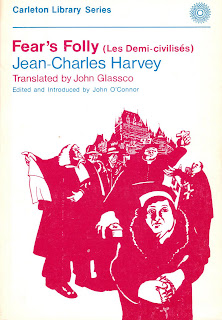
Sugar-Puss on Dorchester Street
Al Palmer
Toronto: New Stand Library, 1949
Sugar-Puss is Gisele Lepine — not Gisèle Lépine — a farmer's daughter from the fictional Laurentian village of St Christophe. At thirteen, she's brought to Montreal for the St Jean Baptiste parade and is enchanted by shining pavement, neon signs and snappy dressers. In an instant, Gisele's 'neat and pleasant' home is 'mentally transformed into one of bleak desolation'. The next five years are devoted to saving and self-betterment, all so that she might one day take her place amongst the city folk — not for her the life of a 'farmette', 'first a slave to a husband then to an ever-growing family.'
Gisele is eighteen when her dream is realized. She returns to Montreal as a beauty blessed with large, firm breasts, 'a legacy of her Norman ancestry', soft brown skin that hints at Basque blood and feet that are 'small and beautifully formed as are those of most French Canadian women.'
Foot fetishists aside, who knew?
Montreal moves at a much different pace than quiet St. Christophe. Gisele gets a job waitressing in a cheap restaurant, but flees after her oily Greek employer tries pawing her. In the next 48 hours, she becomes a chorus line dancer, meets the love of her life, makes a BFF and loses her virginity.
Events were piling up too fast for her to cope with. She couldn't think clearly. She closed her eyes tightly and shook her head to free some of the turmoil that raged within.
Next is a marriage proposal, the move to a luxurious apartment, a shoot-out with police, a death, another marriage proposal, a kidnapping, a car chase, a second death and a walk 'into the brilliant sunshine of Dorchester Street.' It's a helluva week.
This was Al Palmer's first book, published the year before Montreal Confidential. I'd have preferred the latter had it not been for the intriguing cover copy on Sugar-Puss: 'He takes his readers behind the scene of a metropolitan newspaper. He takes them backstage to the city's leading night clubs and introduces them to the fabulous characters he knows so well.' Just who are these people? We meet Jim Schultz, a former boxer, who assures a nervous Gisele: 'you're just as safe as if you were in yah mudda's arms. Safer unless yah mudda's got cauliflower ears.' The 'bistro bossman' of The Breakers — really Slitkin's and Slotkin's — he may have been inspired by one or both of the owners, former boxers. Or the model may have been Maxie Berger, who, like Schwartz, was welterweight champion. And what about Gaston Courtney, the drug dealing night club owner? Who inspired Diane and Trixie, Gisele's fellow hoofers? The questions linger.

Object: 'Sugar-Puss' or 'Sugar Puss'? Picky, I know, but the inconsistency points to the sloppy editing and production values of the News Stand Library. In my copy the very first sentence of the novel fades into nothingness: 'Dorchester Street spews out almost...' Almost what? The mystery is nearly enough to erase the image of vomiting asphalt.
 Access: 'The Best Selling Novel About Montreal' claims the first edition, first printing. However could they have known? News Stand Library's second printing appeared four months later — with a new cover in which Jimmy and Gisele look like pimp and prostitute. Library and Archives Canada doesn't have a copy of either edition; the curious are directed to the Toronto Public Library, the University of Toronto's Thomas Fisher Rare Book Library and the University of Calgary. An uncommon title, prices have risen considerably these last few years, and are currently in the C$60 to C$80 area. One bookseller is offering a copy of the second printing in a very scarce dustjacket. At $C90, it may very well be a bargain, despite some loose leaves.
Access: 'The Best Selling Novel About Montreal' claims the first edition, first printing. However could they have known? News Stand Library's second printing appeared four months later — with a new cover in which Jimmy and Gisele look like pimp and prostitute. Library and Archives Canada doesn't have a copy of either edition; the curious are directed to the Toronto Public Library, the University of Toronto's Thomas Fisher Rare Book Library and the University of Calgary. An uncommon title, prices have risen considerably these last few years, and are currently in the C$60 to C$80 area. One bookseller is offering a copy of the second printing in a very scarce dustjacket. At $C90, it may very well be a bargain, despite some loose leaves.
Related post:
 The end of National Poetry Month. Can't say it was much different from March – at least not here in little Saint Marys. I close with this photo, taken yesterday, of 92 Wellington Street North. This Victorian Italianate, eight short blocks from the home of James MacRae, is the birthplace and childhood home of David Donnell, whose Settlements received the 1983 Governor General's Award for Poetry.
The end of National Poetry Month. Can't say it was much different from March – at least not here in little Saint Marys. I close with this photo, taken yesterday, of 92 Wellington Street North. This Victorian Italianate, eight short blocks from the home of James MacRae, is the birthplace and childhood home of David Donnell, whose Settlements received the 1983 Governor General's Award for Poetry.





















